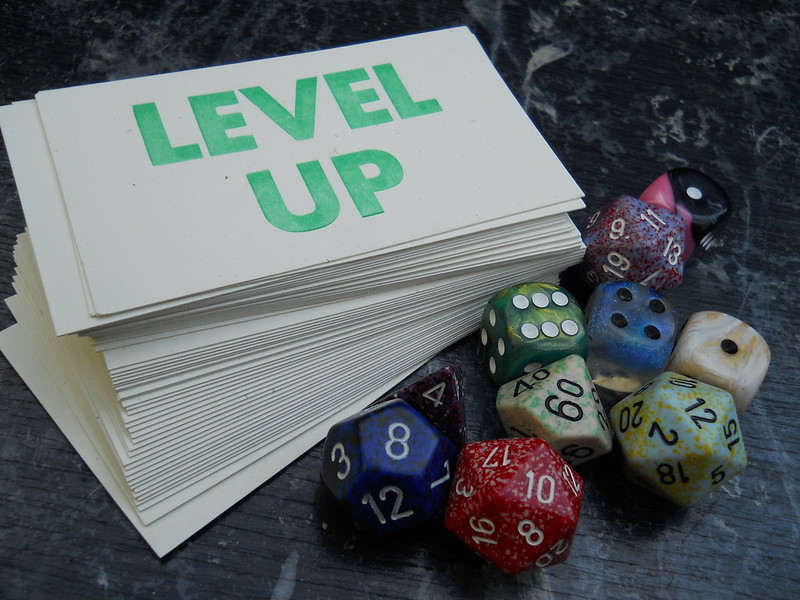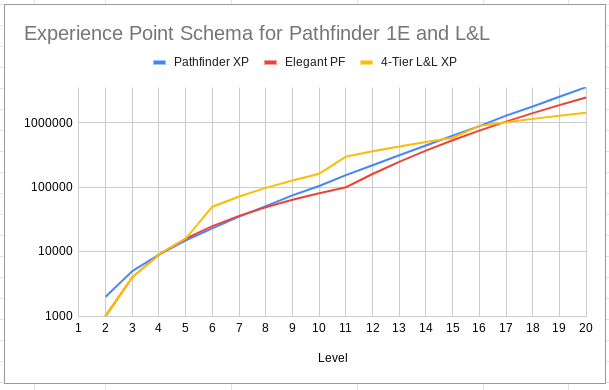|
Old Screeds
|
|
Experience Points in Labyrinths & Liontaurs

What should we use XP for? - In my RPG game, I'm going back to Third Edition's philosophy.
When the good folks at Paizo re-imagined D&D 3E in the form of their then-new Pathfinder game, they wrote rules such that experience points are used exclusively for class progression. XP = levelling, and that's it. In contrast, 3E used XP for other things in addition to level ups, mostly to penalize uneven multiclassing and create magic items. I've found that I dislike Pathfinder's over-dependence on gold as the unit of player power. In Pathfinder, game balance is very much an issue of keeping player gold to strict limits, because player power is very tied up in the items you buy. OK, that's true in 3E D&D too, but at least in that game, you can also use XP as a way to check player power.
I'm returning to that idea in my own fork of D&D 3E, Labyrinths & Liontaurs. Gold is fungible, it comes and goes, and gold costs are only painful until the next big loot pile. On the other hand, experience points are meaningful, and hard-won, and players are reluctant to give them up. That shows they are truly precious -- and therefore, requiring the use of XP to gain power involves real sacrifice, real trade-offs. So what does XP-as-a-unit-of-exchange buy you in Labyrinths and Liontaurs?
- Uneven Multiclassing incurs a 10% XP cost if your class levels are not balanced. That cost is less than it is in 3E, which requires 20% per uneven class, a cost so steep no one would ever pay it. My penalty is much less, and losing a level or two over a career compared with your peers is not that bad.
- Creating permanent magic items will not cost XP, but atuning them will. Thus, the user of the item pays the XP cost, not the maker. And I'm thinking that you put more XP into an item at keystone levels to boost the item further.
- I'm also requiring an XP cost to bring companions back after they are slain.
- And permanent spell effects will require XP as well, per the Permanency spell.
Well then, how many experience points do you need to advance a level? - I'm looking for an elegant solution that fits my philosophy of D&D playing styles.
All these thoughts made me take a new look at the XP tables. Of course, the 3E XP tables are not in the 3E SRD, but Paizo released the ones for Pathfinder. In PF, you can choose slow, average, or fast class progression, with different XP needed per level. That won't work if you have set XP costs for other things -- if you try, then the cost for those other things becomes more onerous on a slow progression, and less onerous on a fast progression. If games have the option of requiring 3,000, 2,000, or 1,300 XP to gain level 2 for a slow, average, or fast game, clearly charging a druid 100 xp to replace a dead animal companion is unfair considering one progression values XP more then twice as much the other.
That means I can't do slow/average/fast progressions in L&L like Pathfinder does. Instead, I need just one set of XP costs per level, and if game masters want to run slow or fast games, they need to award fewer or more XP than usual.
So I looked at Pathfinder's average progression. And I found it to be artificial and inelegant. Require 2K XP to get to 2nd level. 3K more to get to 3rd. 4K more to get to 4th. then 6K more to 5th, 8K more to 6th, then 12K more, then 16 K more, then 24K more, then 30 K more, then 50K more, then 65 K more, then 95K more, then 130K more ... It all seems pretty arbitrary. So I set out to reverse engineer the curve for greater elegance. After playing with the numbers for a while, I came up with these formulae for calculating XP needed to advance to next level:
- Levels 1-10: level squared x 1,000
- Levels 11-20: level to the fifth power
Note that at 10th level, the two curves meet. 10 squared x 1,000 = 100,000 = 10 ^5.
This yeilds a curve that is very close to the current arbitrary xp table used for Pathfinder 1.0. If my entire goal were simply to use the PF system but to make it a bit more elegant and internally consistent, I could call it a day and be done. But that's not my goal. I mentioned keystone levels in L&L. That's part of the philosophical underpinning of my new game -- you see, I believe that "D&D" is really four games in one, with four distinct styles of play. I go into that more here. The gist is that I divide the game into Tiers -- Tyro (level 1-5), Adventurer (level 6-10), Hero (level 11-15), and Legend (level 16-20). And an XP table that reflects this philosophy should reflect this division. And so, for L&L, I'm actually using this as the guideline for setting XP per level:
- Levels 1-5: level squared x 1,000 x1
- Levels 6-10: level squared x 1,000 x2
- Levels 11-15: level squared x 1,000 x3
- Levels 16-20: level squared x 1,000 x4
If you plot these XP schema as line graphs -- with the vertical axis on a log scale -- they look like this:

Looking at the L&L line, you can see the bumps at levels 6, 11, and 16. And you see that all three follow a roughly similar curve. For them whats likes numbers, here are the actual XP tables that I'm talking about:
| Tier |
Level |
Pathfinder XP |
PF Elegant XP |
L&L 4-Tier XP |
|
|
| Tyro |
1 |
0 |
0 |
0 |
|
|
| 2 |
2,000 |
1,000 |
1,000 |
|
|
| 3 |
5,000 |
4,000 |
4,000 |
|
|
| 4 |
9,000 |
9,000 |
9,000 |
|
|
| 5 |
15,000 |
16,000 |
16,000 |
9,000 |
xp per level to advance beyond 5th in epic play |
| Adventurer |
6 |
23,000 |
25,000 |
50,000 |
|
|
| 7 |
35,000 |
36,000 |
72,000 |
|
|
| 8 |
51,000 |
49,000 |
98,000 |
|
|
| 9 |
75,000 |
64,000 |
128,000 |
|
|
| 10 |
105,000 |
81,000 |
162,000 |
38,000 |
xp per level to advance beyond 10th in epic play |
| Hero |
11 |
155,000 |
100,000 |
300,000 |
|
|
| 12 |
220,000 |
161,051 |
363,000 |
|
|
| 13 |
315,000 |
248,832 |
432,000 |
|
|
| 14 |
445,000 |
371,293 |
507,000 |
|
|
| 15 |
635,000 |
537,824 |
588,000 |
87,000 |
xp per level to advance beyond 15th in epic play |
| Legend |
16 |
890,000 |
759,375 |
900,000 |
|
|
| 17 |
1,300,000 |
1,048,576 |
1,024,000 |
|
|
| 18 |
1,800,000 |
1,419,857 |
1,156,000 |
|
|
| 19 |
2,550,000 |
1,889,568 |
1,296,000 |
|
|
| 20 |
3,600,000 |
2,476,099 |
1,444,000 |
156,000 |
xp per level to advance beyond 20th in epic play |
Now, if L&L is really four different games, then you should not have to end a game you like and start a game you do not prefer. That is to say, if you like the gritty realism of Tier One play, and you are unhappy with the crazy overpowered nature of high level hijinks at higher levels, you can simply cap advancement at level 6 and call it a day. But if you want to continue to play your epic 6th level PCs for a while more, at their apex of power, then you can do so. This echoes the "epic" rules in other versions of the game, designed to allow play after level 20. It also echoes play using the E6 ruleset for 3E D&D, or the P6 version in Pathfinder. And it also echoes the slower progression in 1E D&D when characters reached "name" level around level 10. In essence, for L&L, you can cap play at levels 5, 10, 15, or 20, and then advance by levels after that, gaining a significantly decreased power set for each level advance, at a significantly decreased XP cost. That's noted in the table above as well.
Photo credit, with thanks: The photo above, the work of Artnoose on Flickr, is used under a Creative Commons license. People who create stuff and send it out into the world for use by anyone ... those folks are my heroes!
|